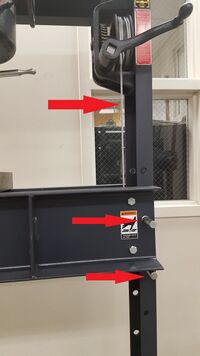Dake 25H Hydraulic Press
A hydraulic press is a device using a hydraulic cylinder to generate a compressive force. Hydraulic presses are commonly used for forging, clinching, moulding, blanking, punching, deep drawing, and metal forming operations.
Safety
- This machine is intended to operated by one person
- Wear proper eye protection
- Establish solid footing before operation
- Keep hands away from press points of operation
- Keep fingers out of pin holes
- Guard the work piece to prevent projectiles from reaching operator
- All pins must be fully inserted before applying pressure
- Never exceed the recommended stroke of 5 inches for this press. Exceeding the stroke will cause damage to the inner packing.
Inspection
Check for physical damage such as bent components, or leaking oil. If Leaking oil is noticed refer to the Troubleshooting guide.
Press Operations
Basics
- Remove the table pins from the table and raise or lower the table with the crank to the desired height.
- Insert the table pins back into the table fully and unwind the crank to remove the tension off of the cables.
- Use the needed cross members if the part is too small to fit the table.
- Make sure the release valve hand wheel is closed so that the pump holds pressure.
- Center the part under the screw nose.
- Slowly pump the handle with an up and down motion.
- Once initial contact between the part and the screw head happens make sure the part is centered under the head before continuing.
- Slowly in a consistent movement pump the handle.
*If the part starts to bend, or lean to one side stop immediately and release the pressure.
- If you are pressing out a part you will have to catch the falling part from under the table.
- Once the part is pressed out or the part is pressed in, slowly release the pressure and allow the head to raise back to the top position.
End of Work
If no other parts are needing pressed
- Leave the release valve open so the head stays at the upper level.
- Clean the area around the press, it should be as clean as you found it.
Best Practices
Some of the best practices to follow:
- Keeping platform clear of debris.
- Smoothing application of pressure.
- Centering the part in the press.
- Securing any non moving parts or fixtures with clamps.
Troubleshooting
*If you see any of the following symptoms see the Machine Shop Manager before proceeding with use.
| Symptom | Cause | Solution |
|---|---|---|
| Oil Leaking from piston oil seal | 1) Reservoir is over filled
2) Piston Packing is warn or damaged |
1) Drain excess oil
2) Replace Piston Packing |
| Press will not hold pressure | 1) Check ball is contaminated
2) Ball and seat have poor contact |
1) Remove and clean Check Balls and Seats
2) Reseat Ball on Seat 3) Replace Piston Packing |
| Press will not build rated tonnage | 1) Pump Plunger Leather is worn or damaged
2) Gauge is defective |
1) Replace Pump Plunger leather
2) Replace Gauge |
| Oil Leaking from pump plunger | 1) Packing Nut is loose
2) Worn Packings |
1) Tighten Packing Nut
2) Replace Packing |
| Oil Leaking from release valve rod | 1) Valve Rod Packing Nut is loose
2) Packing is worn |
1) Tighten Packing Nut
2) Replace Packing |
| Pump handle drifts up | 1) Defective Check Ball
2) Defective Check Ball Spring |
1) Clean Check Ball, Re-seat
2) Replace Spring |
| Ram will not return | 1) Return Spring damaged
2) Piston is bent or damaged 3) Piston Packing is defective |
1) Replace Spring
2) Replace Piston 3) Replace Piston Packing |


